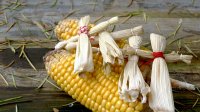Teaching Thanksgiving Thoughtfully
Educators looking to teach a historically accurate version of Thanksgiving can take advantage of a wide variety of resources.
Your content has been saved!
Go to My Saved Content.As Thanksgiving approaches, teachers have the opportunity to engage their students in meaningful discourse about history and how it is remembered.
When I think back on how Thanksgiving was taught when I was in elementary school, I am embarrassed for how my school thoughtlessly turned a learning opportunity into a spectacle. Hopefully, this isn’t a widespread approach to teaching Thanksgiving and is one that will surprise you as well: Half of the first-grade students were dressed up as Pilgrims, and the other half were dressed up as Native Americans. Then, we had an assembly where we sang songs about friendship and being grateful.
That was the only “educational” experience I had with Thanksgiving as a student. My classmates and I missed out on an opportunity to learn an important lesson about the history of our country.
I became a teacher for the purpose of empowering students to seek out information and opportunities; I wanted every student I taught to recognize their own power, develop their confidence, and begin to feel prepared for whatever challenges they faced in and out of my classroom. Those same goals are why I believe students need to be given the opportunity to grapple with the truth behind the stories of Thanksgiving they have previously heard.
Information is powerful and teaches our students to critically analyze where that information comes from—whose stories they are interacting with and whose stories are being left out. These are the types of skills that ensure students can wield this power responsibly.
While many resources are available for teachers who want to bring a thoughtful approach to Thanksgiving into their classrooms, I have focused on the following as a jumping-off point for teachers to use. I would encourage teachers to continually seek out resources both online and in their own communities to make this learning opportunity as impactful for their students as possible. Learn more about how teachers are debunking the myth of Thanksgiving in this 2018 PBS interview.
Resources That Embrace A New Approach to Thanksgiving
A Story of Survival: The Wampanoag and the English: Ideal for kindergarten through fourth-grade students, this lesson plan booklet provides teachers with student-friendly quick facts; five lesson outlines for teaching students about the Wampanoag, the English, and Thanksgiving; and recommendations for texts to explore with students. After completing the lessons in this booklet, students should be able to compare and contrast the lifestyles of the English and the Wampanoag and understand the theme of Thanksgiving.
Rediscovering Thanksgiving: Ideal for third-grade students, this unit uses texts including The Wampanoag (A True Book) and 1621: A New Look at Thanksgiving to address the following essential questions:
- Who were the first people to live in present-day New England? How were their lives and communities impacted by the Europeans?
- What parts of the Thanksgiving story are true? What parts are myths?
- Why is it important to look at history from multiple perspectives?
American Indian Perspectives on Thanksgiving: Ideal for students in fourth through eighth grades, the teacher resource guide provided by the Smithsonian National Museum of the American Indian allows students to explore the deeper meaning of the Thanksgiving holiday through the following themes:
- American Indian cultures
- Time, continuity, and change
- People, places, and environments
- Global connections
Harvest Ceremony: Beyond the Thanksgiving Myth: Ideal for middle and high school students, this short essay and aligned classroom discussion prompts allow students to explore the juxtaposition of the prevailing idea of Thanksgiving and the real story. A few of the prompts are included below.
- The harvest celebration of 17th-century settlers at Plymouth presents a very different image from what we generally think of as the “First Thanksgiving” between Pilgrims and Indians. How far off is the modern story of Thanksgiving from what actually happened?
- What do you think about the idea of the “Thanksgiving myth” as a representation of what we celebrate today?
You don’t need to be an expert on the history of the United States, Indigenous peoples, or Native American history to meaningfully bring these resources into your classroom. Think back on your own experience learning about Thanksgiving: Is that the same experience you want for your students? How can you take advantage of this time of year and help students build their knowledge of history and critical literary analysis skills?
